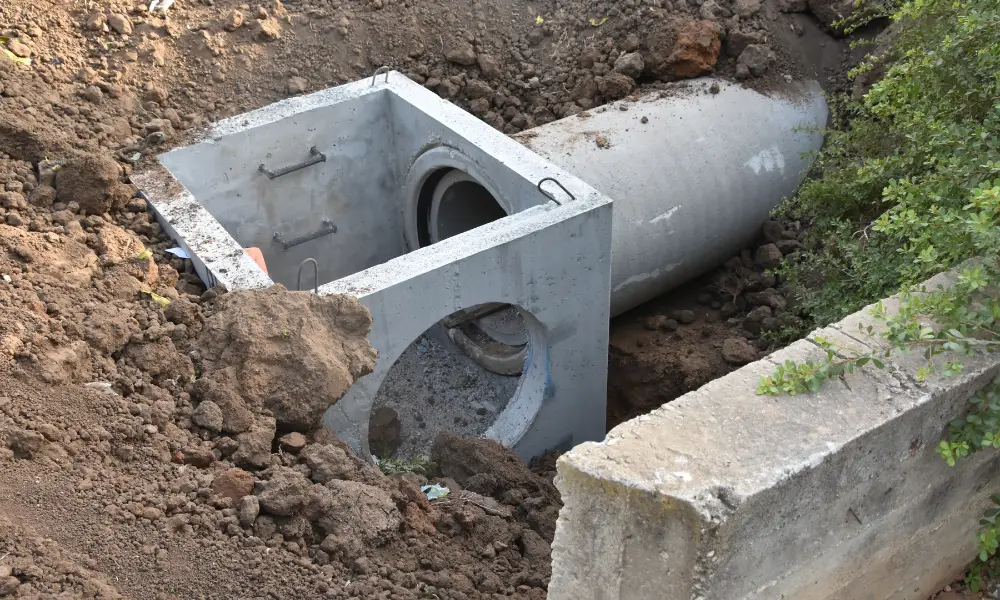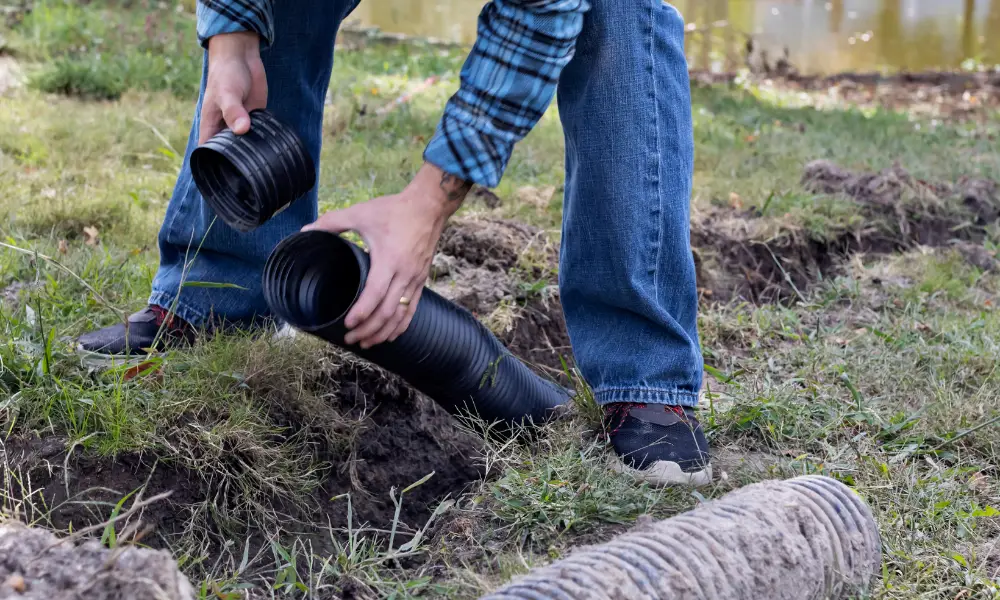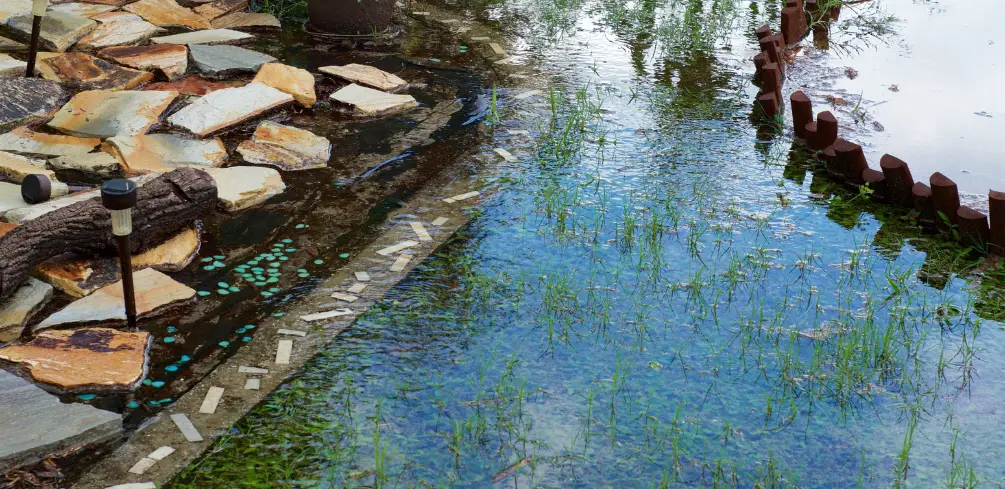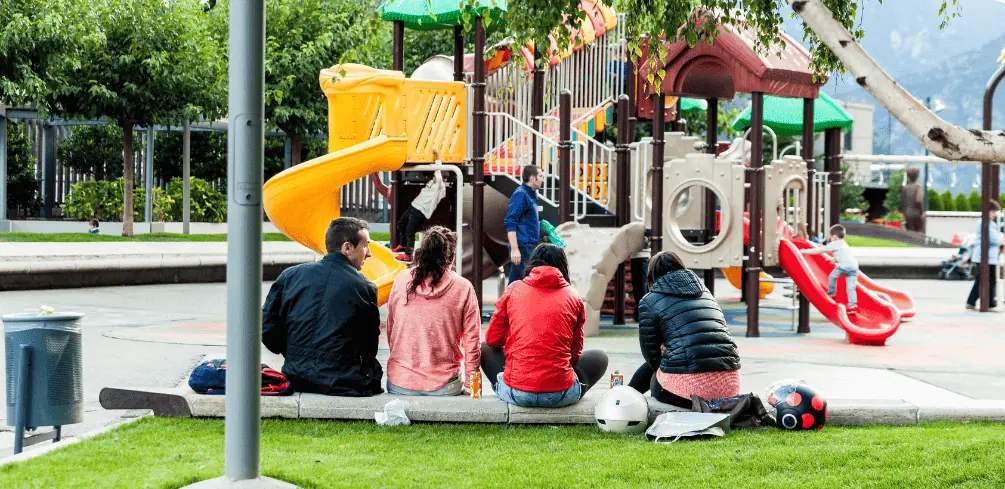You’ve probably found yourself gazing out the window on a rainy day, only to see your backyard transforming into a miniature lake. It’s frustrating and concerning to witness water accumulating in your space, not just because it’s unappealing visually but also due to the potential damage it can cause.
This situation may have compelled you to wonder why this flooding happens and what exactly is going wrong with your outdoor drainage system. Well, you’re not alone in this predicament; many homeowners face similar issues when there are downpours.
The key lies in understanding the science behind water accumulation and assessing your current drainage system. This will help you identify the root of the problem accurately and find an effective solution for better yard drainage.
By choosing appropriate landscaping solutions coupled with a long-term strategy, you’d be armed with tools to combat those pesky floods every time it rains.
Understanding the Problem: Why Water Accumulates

Ever wondered why your yard’s turning into a mini lake every time it pours? Let’s dive in and figure out why all that water is making itself at home!
The first factor you need to consider is the soil composition. Different types of soil have varying capacities to absorb water, hence influencing how quickly your backyard can get rid of excess rainfall.
For instance, sandy soils are usually quick-draining, while clay soils tend to retain water longer due to their compact nature. Therefore, if your backyard has more clayey soil, it could be contributing significantly to the flooding problem.
Next up on our list is understanding rainfall patterns. These patterns greatly influence how much and how often your backyard floods.
If you live in an area with high rain intensity or frequent bouts of heavy downpours, there’s likely not enough time for the water to seep into the ground before more rain arrives—resulting in an overflow situation that transforms your yard into a body of water.
Additionally, seasonal variations might mean periods of increased flooding during wetter seasons.
Taking these factors into account helps you better understand why your backyard turns into a puddle when it rains heavily.
While there are multiple reasons behind this issue, addressing two key aspects—soil composition and rainfall patterns can provide insight into potential solutions for reducing flood risk in future rain events.
Remember: knowledge isn’t just power—it’s also dry feet and a happier garden!
Assessing the Current Drainage System

You’d need to take a good look at your existing drainage system, checking if the water has clear paths to escape or if it’s getting trapped in certain areas, leading to pooling. This is an important step in understanding why your backyard floods when it rains.
Poor drainage maintenance can often be the culprit behind such issues. Blocked drains or gutters prevent water from flowing away efficiently, causing it to accumulate and then flood your yard.
Look for things like debris in gutters and downspouts, damaged drain pipes, or blocked stormwater drains.
Consider these three key elements when assessing your current drainage system:
- Drainage Paths: Are there clear paths for water runoff? These might include sloping landscapes away from your house, trenches, French drains, or stormwater systems.
- Soil Composition: Certain types of soil absorb water more easily than others. Clay soils tend to hold onto moisture, while sandy soils allow for better drainage.
- Gutters and Downspouts: Maintaining these systems is crucial for directing rainwater away from your property effectively.
A close inspection of these aspects will enable you to identify any potential problem areas that may contribute to flooding. If you find that the problem lies with poor soil composition, consider amending the soil with organic matter or sand to improve its draining capabilities.
If blocked gutters are an issue, regular cleaning could be an effective solution.
And should you discover inadequate drainage pathways as the main cause of flooding in your backyard, investing in professional landscape grading services could prove beneficial.
Remember, not everything is about fixing what’s broken; sometimes, enhancing what’s already working well could make all the difference too! So once you have addressed any glaring issues with your existing drainage system – don’t stop there!
Consider implementing additional measures, such as installing rain gardens or dry wells, which serve both functional and aesthetic purposes while improving overall water management on your property.
By doing so, you’ll transform a soggy problem area into an asset that adds value and beauty while ensuring peace of mind during those rainy seasons ahead!
Options for Improving Yard Drainage

If your green oasis turns into a swampy marsh every time the heavens open up, it’s high time to consider some serious yard drainage improvements! The first thing you need to do is understand that not all waterlogged yards are created equal.
Factors such as soil composition, topography, and climate can affect both the severity of your flooding problems and the best solutions for solving them. You may also want to consider sustainable options like rainwater harvesting.
This method isn’t just environmentally friendly—it can also save you money on watering plants.
To help you navigate this soggy situation, here’s a compact table showing two popular yard improvement options:
| Improvement Options | Pros | Cons |
|---|---|---|
| Rainwater Harvesting | Environmentally friendly; Can save money on watering plants; Reduces flood risk by capturing runoff | Initial installation cost can be high; Maintenance required; Legal restrictions in some areas |
| Artificial Turf Installation | No water logging; Low maintenance; Green lawn all year round | Expensive up-front cost; Not as cool as natural grass in hot weather; Doesn’t support bio-diversity like natural lawns do |
As you mull over these alternatives, remember there’s no one-size-fits-all solution when it comes to improving yard drainage. What works for your neighbor might not work for you.
To make an informed decision, take into account factors like the gradient of your land and local rainfall patterns. Consider consulting with a landscape professional—they can provide expert advice tailored to your specific needs and circumstances.
Above all, don’t let the problem languish—the longer you wait to address backyard flooding issues, the more damage they’re likely to cause!
Choosing the Right Landscaping Solutions

Don’t you just long for a stress-free, gorgeous landscape that not only enhances your property’s appeal but also effortlessly tackles those pesky water issues?
The right landscaping solutions can turn this dream into reality.
Choosing suitable plants and adjusting soil composition are fundamental steps in this process.
Opting for native plants that are acclimated to your area’s rainfall patterns and have deep root systems can significantly benefit water management in your yard.
- Plant Selection Benefits: Native plants with deep roots absorb more water than those with shallow roots, thus reducing the amount of surface runoff and minimizing flooding. Additionally, these types of plants typically require less maintenance as they’re adapted to local conditions.
- Soil Composition Importance: Soil plays a crucial role in managing rainwater as well. Sandy soils tend to drain quickly, while clay soils retain water longer due to their compact nature; hence choosing the right balance is key. Incorporating organic matter or compost into your soil can improve its structure and enhance its ability to absorb and hold onto rainwater.
- Creating Water Channels: Another solution might be creating natural-looking dry creek beds or swales (shallow ditches) filled with gravel or pebbles that guide excess rainwater away from problem areas.
A rain garden is another effective way of dealing with backyard floods while adding aesthetic value. It involves digging a shallow depression in your yard where water collects during rains, then filling it up with native shrubs, perennials, and flowers designed to withstand temporary flooding.
This transforms a problem spot into an attractive feature while providing an environmentally friendly solution for overflow rainwater problems without using pumps or drains!
Keep in mind the importance of plant selection benefits and soil composition when designing your rain garden to ensure it effectively handles excess moisture while enhancing the beauty of your landscape.
Implementing a Long-Term Strategy to Prevent Flooding

Implementing a long-term strategy to prevent flooding is like preparing your garden for a marathon, where success lies in endurance and thoughtful planning.
A truly effective plan won’t just solve the immediate problem of water pooling, but it’ll also ensure that your backyard remains healthy and resilient for years to come.
One such strategy you could consider is rainwater harvesting. This involves capturing rainwater from rooftops or other surfaces before it reaches the ground and storing it in tanks or barrels for later use.
Not only does this reduce the amount of water hitting your yard during heavy rains, but it can also provide an excellent source of irrigation during drier periods.
As part of your flood prevention strategy, consider incorporating landscape features designed specifically to control runoff. Swales, for instance, are shallow depressions that guide excess water away from vulnerable areas, while rain gardens are attractive planting beds designed to absorb stormwater runoff.
You may also want to look into installing permeable paving materials on walkways or patios which allow rainwater to seep into the ground rather than pooling on hard surfaces.
It’s worth bearing in mind that such measures require careful planning and execution: they need to be appropriately sized and positioned according to both the layout of your yard and the amount of rainfall it receives.
While implementing these preventive measures, don’t overlook the importance of having flood insurance as part of your overall strategy.
No matter how well you prepare, there’s always a chance that an exceptionally heavy downpour could overwhelm even the best-laid plans—especially with climate change increasing the likelihood of extreme weather events.
Flood insurance can give you peace of mind knowing that if worst comes to worst, you’ll have financial protection against potential damage caused by flooding events.
Remember, though, prevention is better than cure – so keep up with those maintenance tasks like checking drainpipes for blockages and keeping gutters clean!
With patience and persistence, you can create a backyard that stands tall no matter what Mother Nature throws at it.
Conclusion
Don’t rest on your laurels yet. Remember, preventing your yard from resembling the Great Lakes post-rainfall is a marathon, not a sprint. Stick to that long-term strategy.
Mother Nature might be stubborn, but with science and determination on your side, you’ll keep her at bay!





